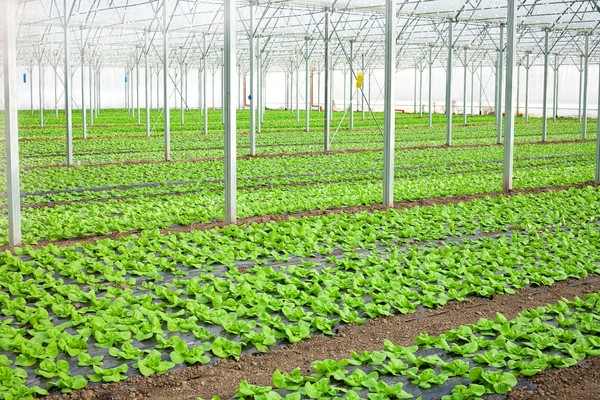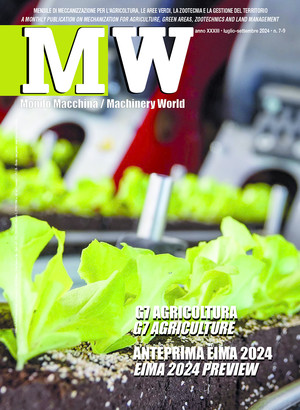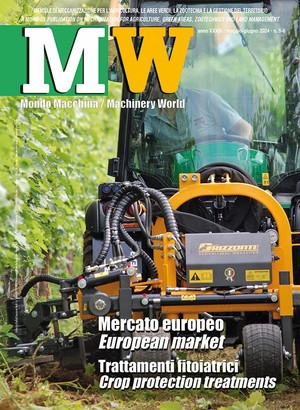
Mechanisation for phytosanitary defence of 'baby leaf' salads
Plant protection treatments are a key action for the proper development of baby leaf salads. Suitable products and advanced, spraying machines are needed for the best product quality, also with regard to food safety
The production of 'baby leaf' salads, concentrated mainly in Lombardy and Campania, plays an important role in the Italian fruit and vegetable sector. Cultivated in repeated cycles, this crop requires careful pest management which, if not managed properly, can cause significant environmental damage. The appropriate choice of active ingredients, machines for their distribution and the study of the most effective techniques are therefore fundamental steps for responsible cultivation.
Correct agronomic practices. Baby leaves include a wide variety of species: rocket, spinach, lamb's lettuce, lettuce, chicory, watercress, chard and brassicaceae, most of which are grown in greenhouses, obtaining fresh leaves to be eaten as salads. Their ideal growing environment involves loose soil with good water retention but no stagnation, and irrigation water with a very low salt concentration free of contamination. Watering must be frequent, until the seedlings fully emerge. In soils prone to surface crust formation, it is advisable to reduce water volumes while increasing the frequency of interventions. With high sowing densities, sprinkling irrigation requires attention to avoid the risk of fungal attacks on close-set leaves. To avoid soil impoverishment and maintain fertility, it is crucial to adopt appropriate crop rotation and non-chemical methods for sanitisation, such as solarisation, biocide cultivation, steam application or inoculation of biological microorganisms. A careful fertilisation plan, based on chemical and physical analyses of the soil, helps to ascertain the actual macro-nutrient requirements. It is often necessary to intervene with phytosanitary treatments, aimed at the prevention of fungal diseases and insect attacks; the method of distribution is crucial for the success of the treatment and for the protection of the health of the operator and the environment. In addition, the weather conditions must be suitable: the wind must not exceed 3-4 m/s, and the temperature must not exceed 25° C. The early hours of the morning are therefore the most suitable. In order to reduce drift, the correct distance between nozzles and target must be maintained, preferably adopting anti-drift nozzles and asymmetrical end-of-boom nozzles.
In emergency situations, cannons are still used to distribute plant protection products in greenhouses and tunnels. However, this practice entails several problems, such as high dispersion of active ingredient in the environment and contamination of surrounding surfaces. To reduce (at least in part) these negative effects, the tunnel header opposite the entrance can be closed, but the uniformity of distribution is compromised. The use of the cannon is only permitted in the absence of the operator inside the tunnel, using external or mobile sprayers on remote-controlled tracks. Any tractors used must of course be equipped with active carbon filters and a pressurised cab. In addition, the structure must remain closed until the water of the sprayed mixture has completely evaporated. For the tunnels where treatments are carried out, a minimum distance of at least 50 m from dwellings is required, while the flow of product launched with the cannon must be directed in the opposite direction.
Spray booms. They are a much more effective solution because the distribution of the mixture is targeted on the crop, thus reducing dispersion and improving the effectiveness of the treatment. For the best distribution uniformity through the nozzles, it is important to keep the height of the boom constant from the target, avoiding oscillations and jerks as much as possible. The most suitable nozzles for this purpose are fan nozzles, as they ensure effective coverage of the foliage. Numerous models are available on the market, differing in droplet size, spray angle and flow rate. Anti-drift nozzles are designed to reduce product dispersion in the atmosphere, as they generate droplets that contain tiny air bubbles, thereby increasing the diameter and reducing drift. The 'end-of-boom' nozzles have an asymmetric spray pattern, which avoids product dispersion in areas not subject to treatment. However, specific adjuvants are also available which, when added to the mixture, further reduce product dispersion.
Technological evolution. The control of boom sections makes it possible to selectively interrupt distribution, thus avoiding spraying already treated areas and reducing overlapping and product waste. The application of prescription maps, with the support of high-precision GPS RTK geo-referencing, allows site-specific application of the quantity of product, while specific sensors (usually ultrasonic) adjust the height of the boom from the target, also depending on the terrain profile. PWM (Pulse Width Modulation) electronic pulse nozzles are an advanced technology, mainly adopted on sprayer booms to optimise spraying in open fields. The duration of each mixture pulse and the interval between pulses are variable, so that the amount of liquid distributed can be precisely adjusted to suit the specific needs of the crop. The actively controlled version, such as John Deere's ExactApply, uses sensors and actuators to adapt the flow rate in real time according to the forward speed of the sprayer and the characteristics of the trajectory travelled. A recent innovation is Caffini's Sprayveg, which is specifically designed to treat baulated crops, such as baby leaf salads and vegetables in general. Thanks to the 7.20 m asymmetrical hydraulic shutter boom, up to four sections can be processed per pass. The nozzles have a wheelbase of only 25 cm, for the most even distribution possible, also made possible by the AirWings air sleeve and, when appropriate, the electrostatic function.
A rather common solution for baby leaf salad crops is the use of integrated irrigation systems for phytosanitary treatments in greenhouses, especially for the distribution of some systemic products and herbicides. The phytoiatric mixture can be added to water for drip irrigation or micro-sprinklers, the elements of which are placed close to the root system. An alternative is full-coverage micro-spraying, spraying or sprinkling. In particular, the spray technique produces small droplets, which is ideal for active ingredients that act by covering the vegetation. Naandajain's Fogger sprayer is designed for plant protection treatments in greenhouses and microclimate management, regulating humidity and temperature. Thanks to its very small droplets (about 55 μm in average diameter), it can efficiently distribute both crop and foliar fertilisers, but also biostimulants and growth regulators.
The future: drones... A promising approach for the future of phytosanitary treatments on baby leaf salads involves the use of drones, especially for site-specific interventions. The possibility of being able to install sensors and cameras to monitor the crop extends its potential. However, there are some critical points: compared to the desirable requirements, the load capacity is limited and the flight range is short. In addition to these technical challenges, there is still some regulatory complexity surrounding the use of drones in agriculture, with specific restrictions and licensing requirements. However, the drone lends itself well to the application of unconventional defence techniques: the start-up Pats of the Technical University of Delft has developed PATS-X, to control the proliferation of moths in greenhouses, thus reducing the need to intervene with insecticides. Inspired by bats, the drones identify and eliminate moths, interrupting the pests' reproductive cycle.
...and robots. They reduce (or even eliminate) manual intervention, with improvements in efficiency and precision in the application of plant protection products, as well as avoiding any possible danger of contamination for the operator. Equipped with advanced navigation systems, including GPS, Lidar, multispectral, thermal, ultrasonic sensors, etc., and enabled by the application of artificial intelligence, they can move autonomously within the greenhouse, map their surroundings, detect obstacles and plan optimal routes for crop treatment. In addition, they can detect the onset of diseases and stress states in plants in a site-specific manner in real time.
Functional check and calibration of sprayers
As of 26 November 2016, in Italy sprayers (listed in the annex to the Ministerial Decree 4847 of 3.3.15), must be subjected to mandatory periodic functional checks, to be carried out at authorised test centres, at different intervals, as follows: models first placed on the market must be inspected within five years from the date of purchase; thereafter, the control interval should not exceed three years; machinery used for contracting work must be checked periodically at intervals not exceeding two years; sprayers combined with operating machines, such as seeders and weeders, must be checked every 6 years. If used by contractors, checks must be carried out every four years; manually-operated or fanless knapsack sprayers, when used in protected crops, are excluded from the mandatory periodic functional check.
In addition, in some regions there is also provision for instrumental calibration, to be carried out at a test centre, usually at the same time as the functional check.








